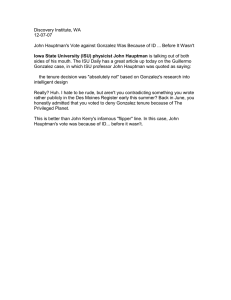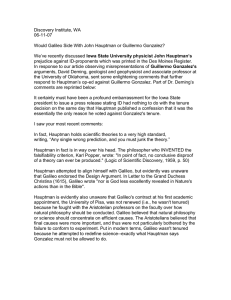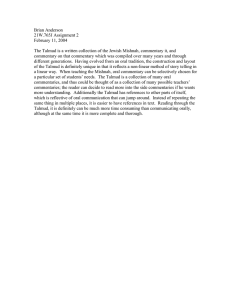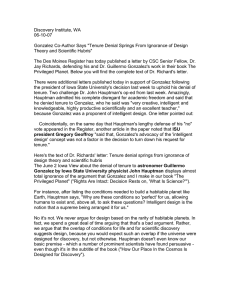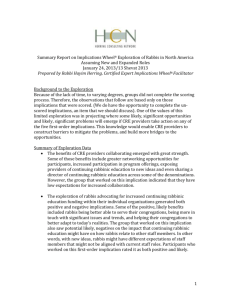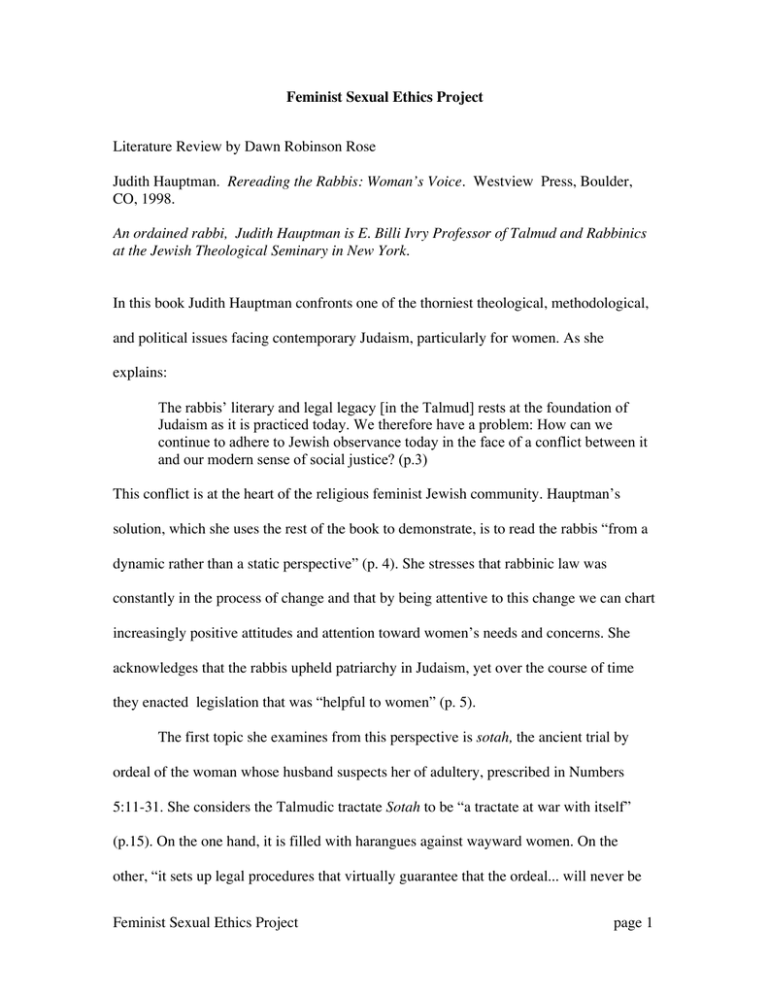
Feminist Sexual Ethics Project
Literature Review by Dawn Robinson Rose
Judith Hauptman. Rereading the Rabbis: Woman’s Voice. Westview Press, Boulder,
CO, 1998.
An ordained rabbi, Judith Hauptman is E. Billi Ivry Professor of Talmud and Rabbinics
at the Jewish Theological Seminary in New York.
In this book Judith Hauptman confronts one of the thorniest theological, methodological,
and political issues facing contemporary Judaism, particularly for women. As she
explains:
The rabbis’ literary and legal legacy [in the Talmud] rests at the foundation of
Judaism as it is practiced today. We therefore have a problem: How can we
continue to adhere to Jewish observance today in the face of a conflict between it
and our modern sense of social justice? (p.3)
This conflict is at the heart of the religious feminist Jewish community. Hauptman’s
solution, which she uses the rest of the book to demonstrate, is to read the rabbis “from a
dynamic rather than a static perspective” (p. 4). She stresses that rabbinic law was
constantly in the process of change and that by being attentive to this change we can chart
increasingly positive attitudes and attention toward women’s needs and concerns. She
acknowledges that the rabbis upheld patriarchy in Judaism, yet over the course of time
they enacted legislation that was “helpful to women” (p. 5).
The first topic she examines from this perspective is sotah, the ancient trial by
ordeal of the woman whose husband suspects her of adultery, prescribed in Numbers
5:11-31. She considers the Talmudic tractate Sotah to be “a tractate at war with itself”
(p.15). On the one hand, it is filled with harangues against wayward women. On the
other, “it sets up legal procedures that virtually guarantee that the ordeal... will never be
Feminist Sexual Ethics Project
page 1
implemented...” (p.15).1 Of course, we have to remember that the rabbis did not have the
political wherewithal to enforce these laws, since they lived under foreign rule.
In the following chapter, Hauptman discusses relations between the sexes,
focusing on various interpersonal dynamics. Hauptman suggests that rabbinic discussions
of this topic are predicated on three general principals:
(1) men are easily aroused sexually by being in the presence of women, looking at
them...or even just thinking about them; (2) women, in general, do not actively try
to entice men; (3) sexual attraction in and of itself is considered to be normal and
natural but, because it demands resolution, can easily lead to violation of social
and religious norms. (p. 31)
She goes on to consider many texts, primarily from tractate Kiddushin in which small
groupings of men and women are forbidden from being alone together because of the fear
that forbidden sexual activity will take place. In the rabbinic mind, arousal demands
resolution. It is best, particularly for a man, not to be put in that position. The texts are
not written addressing women, and except for individual women who are named, it is
clear (from the texts that Hauptman chooses) that women are not feared as people who
are actively trying to entice. However, the rabbis do expect women to be very careful not
to be enticing in their dress, speech, and movement.2
Perhaps most interesting is the chapter on rape and seduction in which
Hauptman traces the many stages of thinking between Biblical and rabbinic law. To
begin, according to the Torah, seduction and rape of an unwed girl were crimes against
her father, for he would not only lose the anticipated bride-price for his daughter’s
1
This is highly indicative of rabbinic methodology. Laws (particularly scriptural laws) once on the books
are rarely if ever directly abrogated. Rather, such laws are limited by qualification after qualification until
they can almost never be implemented. A prime example of this is the laws surrounding capital punishment
in Mishnah Sanhedrin. On the one hand, the methods of capital punishment are described in gory detail. At
the same time the rabbis develop so many stringencies in the laws of evidence that it becomes nearly
impossible to convict someone of a capital crime.
2
This expectation obviously continues to varying degrees of extremity today.
Feminist Sexual Ethics Project
page 2
virginity but also have the onus of having to marry off “damaged goods.” Torah law is
concerned with giving him justice. In Exodus 22:15–16 and Deuteronomy 22:28–29, we
find the laws that stipulate money (a payment for damages) given to the father and the
daughter married by both the seducer (Exodus) and the rapist (Deuteronomy).
The view in the Mishnah3 is markedly changed. A fixed sum for damages is still
paid to the father, but in addition the seducer pays variable amounts for shame and
blemish; the rapist pays for shame, blemish, and pain. These added categories relate to
and are in compensation for whatever it is that is felt by and happens to the girl herself.
The difference between this and the bare Biblical law cannot be overstated. The legal
focus has been moved to the girl. Out of the five categories of compensatory damages
generally prescribed in mishnaic law (damage or blemish, medical expenses, lost wages,
shame, and pain) two have been awarded the seduced girl and three the raped.
In Babylonian Talmud Ketubot 39 a–b, the rabbis attempt to understand pain from
a legal standpoint, pain being part of what distinguishes seduction from rape, according
to Mishnah Ketubot 3:4. What is the pain a girl, a virgin, experiences during rape? Their
ignorance is painful. “It was pain because she was pushed down!” “But what if she was
pushed down on silk pillows (i.e., she would not feel pain).” Men and women are both
quoted (though none who are identified as having been raped) in the course of the
discussion. Some statements seem hostile to women, especially to raped women, denying
that they do have pain. The Babylonian Talmud ends its discussion in the air, but with the
initial ruling of the Mishnah intact. Raped women are to receive compensation for pain
(even though we do not yet understand the nature of that pain). Interestingly, Hauptman
3
Mishnah Ketubot 3:4.
Feminist Sexual Ethics Project
page 3
points out that the Jerusalem Talmud falls much more squarely on the side of the raped
woman, as it explains:
There is no comparison between engaging in sex by force and doing so willingly.
There is no comparison between engaging in sex on a dunghill and engaging in
sex in the bridal chamber. (Jerusalem Talmud Ketubot 3:5, 27c)
Thus, insists Hauptman, the rabbis are feeling their way toward what we would call
justice today.
Hauptman makes a similar argument in considering the laws of divorce, though
her arguments here are much more subtle. The rabbis had for their base text the verses in
Deuteronomy 24:1–4, which state that if a man takes a wife and then finds something
unseemly in her, he may write her a bill of divorce, put it in her hand, and send her out of
his house. Nowhere does this suggest that the woman has any agency or decision-making
power to either initiate or resist.
In her treatment of this topic, Hauptman points out that grounds on which a man
might divorce his wife are not discussed until the end of Mishnah Gittin (9:10). There we
have three opinions, and the legal outcome is undecided. This might leave the impression
that the most liberal opinion, namely that a man may divorce his wife for most any
reason, is an acceptable view. But Hauptman asks us to look again. Structurally, this
mishnah falls at the end of tractate Gittin. This is normally the position in mishnaic
tractates of aggadic stories and homilies, rather than legal material. Moreover, she asks us
to examine what has come before. The nine chapters of Gittin have piled stricture upon
stricture on the divorcing husband: how the bill of divorcement (get) will be written, how
it will be delivered, and how he will have to liquidate his property to pay off his wife’s
marriage contract (known as the ketubah), etc. According to Hauptman, there has been
Feminist Sexual Ethics Project
page 4
nothing frivolous, easy, cheap, or quick about this process, and there are no rewards for
the man who enters into it lightly.
Much of tractate Gittin is concerned with insuring that a woman who thinks she
has a valid divorce document (known as a get) indeed has one. Rabbinic law also
specifies that the consequences of error could be quite horrific, with intergenerational
repercussions. If a woman who thinks she is divorced--but is not--remarries, she is
considered an adulteress and her children mamzerim, a caste of Jews forbidden to marry
any Jew but of their own kind. Thus, Hauptman traces the rabbinic effort in Mishnah
Gittin to block vacillating husbands from wreaking havoc on their ex-wives. Most
notably, in one of the first uses of the term mipnei tikkun ha-olam (in order to heal the
world, or repair the social order), Rabban Gamliel made a law that prohibited men from
convening a court in another city to cancel a get before it reaches his wife (i.e., without
his wife’s knowledge).4
Later rabbis in the gamara will ask what tikkun ha-olam means here. Rabbi
Yohanan thinks it is to reduce the number of mamzerim, while Resh Lakish the number
of abandoned wives unfree to remarry because they have not received a bill of
divorcement (known in Hebrew as “chained women” [agunot]). Astonishingly, the rabbis
go on to say later on the same page (daf) that if the husband cancels the get without the
wife’s knowledge, the betrothal is retroactively annulled.5 When the husband betrothed
the woman, he did so by the laws of Israel and thus somehow promised to conduct the
marriage by those laws, as defined by the Sages. In annulling the get without her
4
5
Mishnah Gittin 4:2
Babylonian Talmud Gittin 33a, citing Tosefta Gittin 3:3.
Feminist Sexual Ethics Project
page 5
knowledge, he breaks the law of the Sages. The entire marriage is therefore annulled
before it is begun.
Another rabbinic innovation Hauptman examines is that of the divorce document
given under compulsion. Though it is not discussed at length, there is a straightforward
mishnaic statement regarding the legitimacy of a get given when the husband is under
court order to divorce his wife, whether by Jewish or non-Jewish courts.6
Because a get is to be issued by the male of his own free will, the contradiction
might be expressed thusly:
And similarly with bills of divorce: They exert force on him until he says, I wish
to [write this get of my own free will].7
Here, again, it is not directly in a woman’s hand to dissolve a marriage, but we begin to
see how a court (beit din) might act for her or at her request—if it felt that she had
sufficient grounds. There are numerous reasons given in the Mishnah and Gemara why a
woman could divorce a man, ranging from physical revulsion to a deep desire to move to
Palestine. There is evidence all through the Talmud of various rabbis and sages
compelling men to give bills of divorcement (gittin), though often amid controversy.8 The
power is clearly there from the Mishnah, although the guidelines are not well demarcated.
Hauptman has introduced this chapter on divorce as yet another example of the
rabbis bettering the lot of women while still bound by the patriarchal halachic system.
Many Jews today are basically non-halachic and so think little of the problems of gittin.
However, Jews in Israel or Orthodox Jews are bound by the same halachah we have just
been discussing, and for them, many of the same problems still apply.
6
Mishnah Gittin 9:8.
Mishnah Arakin 5:6.
8
See, for example, Tosefta Gittin 88b.
7
Feminist Sexual Ethics Project
page 6
In addition to these issues, Hauptman also devotes a chapter to marriage
procreation, and legal matters relating to menstruation.
Hauptman’s reading is selective, hopeful, and certainly tells part of the story. Her
underlying purpose seems to be to make it possible for women to remain in
communication with the tradition, to show that the tradition has been somewhat female
friendly, and that change is possible, because change was occurring in talmudic times.
What she does not tell us is how to use this information to make change today, and that is
where the book is somewhat limited. Without an understanding of what became the
structure and tradition of halachic thinking over the centuries since talmudic times,
efforts in traditional communities can be misguided, both legally and culturally.
Some Jewish feminists regard their work as an effort to keep Jewish and feminist
together. Judith Hauptman is a most excellent example of exactly that.
http://www.brandeis.edu/projects/fse/
Feminist Sexual Ethics Project
page 7

